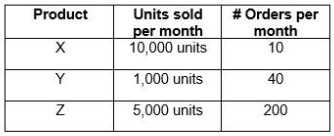APICS cltd practice test
Certified in Logistics, Transportation and Distribution Exam
Question 1
Which of the following theories is illustrated in the list below?
Stage 1: A new product is created to fill a domestic need and produced locally.
Stage 2: The newly created product is offered to international customers.
Stage 3: International customers develop expertise and offer the product at a lower cost to the
original country.
- A. International product life cycle theory
- B. Porter's cluster theory
- C. Sheffi's logistics cluster theory
- D. Theory of Comparative Advantage
Answer:
A
Question 2
Which of the following modes of transportation is typically associated with detention charges?
- A. Rail
- B. Water
- C. Pipeline
- D. Truck
Answer:
B
Question 3
Stockout frequency refers to:
- A. the probability that a firm will not have inventory available to meet customer orders.
- B. a single event where a firm will not have inventory available to meet customer orders.
- C. the cost of sales that a firm will have when insufficient inventory is available to meet customer orders.
- D. the percentage of days in which inventory necessary to meet customer orders is missing.
Answer:
A
Question 4
The task that best describes the value proposition offered by freight forwarders is that they:
- A. act as agents for domestic firms in international markets, primarily obtaining orders for their clients' products.
- B. export goods and services and locates overseas buyers on their clients' behalf.
- C. consolidate shipments from various customers and offer lower transportation rates.
- D. operate under power of attorney from the shipper to pay all import duties and are ultimately liable for unpaid duties.
Answer:
A
Question 5
A logistics manager seeks total integration of components that are essential to achieve stated
objectives. Which of the following frameworks would be best to implement?
- A. Systems concepts and analysis
- B. Total cost of ownership (TCO)
- C. Lean six sigma concepts
- D. Network inventory cost minimization
Answer:
A
Question 6
Which of the following supply chain risk management maturity model attributes provides visibility to
impending disruptions and enables the establishment of effective, preventive, and mitigation plans?
- A. Visibility
- B. Predictability
- C. Resiliency
- D. Sustainability
Answer:
C
Question 7
Airfreight companies often use dimensional (dim) weight to cost out shipments because of which of
the following attributes of the product?
- A. Density
- B. Height
- C. Weight
- D. Value
Answer:
C
Question 8
Which of the following terms refers to an integrated approach of simultaneously selling to
consumers through multiple distribution channels?
- A. Omni-channel
- B. Multi-channel
- C. Business-to-consumer (B2C)
- D. E-commerce
Answer:
B
Question 9
Which of the following sets of elements are the major components of inventory carrying cost?
- A. Capital, storage space, inventory service, transportation
- B. Storage space, inventory service, inventory risk, transportation
- C. Capital, storage space, inventory service, inventory risk
- D. Capital, storage space inventory service, distribution
Answer:
C
Question 10
A motor carrier is in a dispute with a customer over who is responsible for unloading goods at the
customer's location. Which of the following documents would be used to resolve the dispute?
- A. Freight bill
- B. Bill of lading (B/L)
- C. Routing guide
- D. Domestic terms of sale
Answer:
D
Question 11
A warehouse manager is performing an ABC segmentation of the products in the warehouse Based
on the three items shown below, what is the correct warehouse segmentation for these items from
the warehouse manager's perspective?
- A. A = Product X, B = Product Z, C = Product Y
- B. A= Product Y, B = Product Z C = Product X
- C. A= Product Z, B = Product Y, C = Product X
- D. A = Product Z, B = Product X. C = Product Y
Answer:
A
Question 12
A company calculating shipping volume in unit load device containers is focusing on which mode of
transportation'?
- A. Trucking
- B. Ocean shipping
- C. Air freight
- D. Barges
Answer:
C
Question 13
A logistics manager is asked to perform a total cost analysis for the organization. Which of the
following trade-offs is critical to consider?
- A. Inventory carrying costs vs. production costs
- B. Distribution costs vs. order processing costs
- C. Transportation costs vs. inventory carrying costs
- D. Landed costs vs. production costs
Answer:
C
Question 14
Which of the following ships are specifically designed to carry ISO shipping containers?
- A. Break-bulk freighter
- B. Roll-on/roll-off (RORO) vessel
- C. Dry-bulk freighter
- D. Cellular vessel
Answer:
A
Question 15
An American company that ships bulk product manufactured in Asia and sold in Europe may consider
which of the following intermodal practices to help minimize total transportation costs?
- A. Rail bridge
- B. Last mile delivery
- C. Landway
- D. Land bridge
Answer:
A